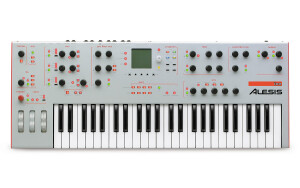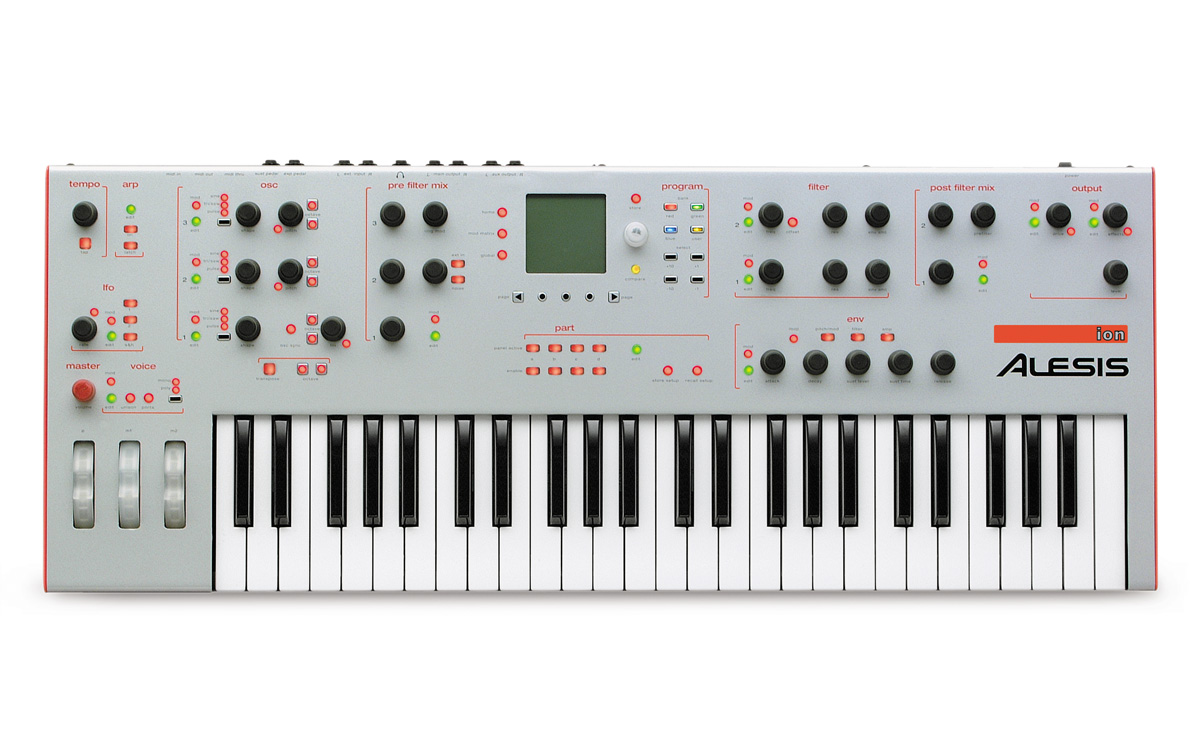View other reviews for this product:
« A great machine that not look »
Published on 04/13/11 at 15:24A quick turn on the features of this synth just to be clear. It is created by a VA KRAFTWERK consisting roughly as follows:
- Three oscillators that can modulate one another (FM ...), Hard sync with forms wave that can easily edit and tweak (orientation of the teeth saws, hack the sin etc etc ...) and opportunities for three-operator FM (well not comparable with a DX 7).
- The output levels of the oscillator section to determine how you attack the filters. Routing output to the filters in some "custom" (eg we can say that osc 1 enters the filter 2 only, and in the filter 1 osc1 ...).
Opportunities to emulate a sort of drift (like vintage) moderately successful.
- A filter section "Custom". There is a variety of filters including filter emulations Jupiter 8, Minimoog, ARP 2600, TB 303 and Oberheim SEM and a filter made in abundance Alesis (forming, vocal, 18db etc etc ...). We decide what filter is assigned two slots. We find all the editing parameters classic filters (cutoff, resonance, envelope etc etc ...). Mixer at the output filters are divided on how the outputs of the machine and a multieffect correct (without exception).
- Two LFOs, S & H, two envelopes and a very good modulation matrix (rather than be without the complexity of that of Andromeda). - An 8-channel polyphony (enough), a connectivity standard that we will not detail, and keyboard quality is very poor. Today it is manufactured as such and replaced by miniak Akai is built on the same sound engine.
UTILIZATION
Operation is simple, once we pass over an hour. Very quickly you quickly understand the operation as long as you've done a bit of analog synthesis.
At first they may sometimes be surprised by certain behaviors, but we understand and we quickly adapted his work (I think among other routing sometimes surprising and the offset of the filter 2 ...).
Otherwise we are quickly scent the doc is very well done and very educational for a beginner in synthesis. The screen often criticized, more than enough.
SOUNDS
Just in the facts, without either extend too. Firstly one may wonder about the quality of emulations filters vintage. The patch is close to the original, even if "too clean", the Arturia Origin emulates much better on an almost identical (on the stamp) but it's not the same budget.
Alesis proprietary filters are great and can make sounds and hyper original typed. In general all the filters have a very special grain to the Ion, both very deep and sharp, even if ...
Digital but good. Say what would have been perceived as a defect on any other VA niquel passes on the Ion and is part of the soul of the machine. Finally the filters really new exiting.
Depending on the settings, it tears, it has a potato in hell, not that the machine have fast envelopes (they are rather molassones elsewhere but there are worse), but filters very well compensated because of their character super soaked and can be very aggressive.
The oscillator section is nice and can do lots of things, but they sound a bit "thin". The filters catch much sauce. FM is very original and very efficient, the Ion is one of the few VA synth (or analog) to help make real hard sync which contrasts very strong. So yes it is not a Prophet 5 but ...
Ditch emulations of vintage filter on elements of sound synthesis "modern" offered by the CSO and a sound world that only knows how to open the Ion. Generally it is a machine that has a grain to it, which happens to mimic very accurately filters vintage stamps to create amazing things.
Any records, it is quite comfortable "in his own way," very expressive. It is a very special machine with a grain of her own. Compared to a Nordlead: Nothing to see (see my review on the Nord Lead 3). The Ion is more juicy and pulls a lot more.
Nordlead has the strongest envelopes. Compared to the Virus (which I could listen): The Ion is more ... "Analog" and sounds much better for my taste. The virus has inevitably sounds pretty "cold and hard", where the ion has more range I think.
Compared to the V-Synth: No report, machines are incomparable because very very different. The effects of the V-Synth are excellent and well ahead of those of the Ion.
Compared to Roland Gaia (the youngest): The Ion bury the Gaia. There are no photo shadow of a second, the Ion is really tying or Gaia is not the slightest frown satisfaction and emotion.
Finally we may regret in the high octaves or a little extreme modulations the presence of aliasing: a pity. Nothing comparable with Gaia is a curse but ...
OVERALL OPINION
It is ultimately a great machine, really. It is important not to use it as an emulation of vintage machinery, that would be to miss the Ion and its excellent opportunities.
More manufactured, value for money on this opportunity is currently excellent. The choice is again without hesitation despite the keyboard really bad and even in the midst of a large set of analog prestige, it is very appropriate and relevant, he brings his personality that no other synth has.
- Three oscillators that can modulate one another (FM ...), Hard sync with forms wave that can easily edit and tweak (orientation of the teeth saws, hack the sin etc etc ...) and opportunities for three-operator FM (well not comparable with a DX 7).
- The output levels of the oscillator section to determine how you attack the filters. Routing output to the filters in some "custom" (eg we can say that osc 1 enters the filter 2 only, and in the filter 1 osc1 ...).
Opportunities to emulate a sort of drift (like vintage) moderately successful.
- A filter section "Custom". There is a variety of filters including filter emulations Jupiter 8, Minimoog, ARP 2600, TB 303 and Oberheim SEM and a filter made in abundance Alesis (forming, vocal, 18db etc etc ...). We decide what filter is assigned two slots. We find all the editing parameters classic filters (cutoff, resonance, envelope etc etc ...). Mixer at the output filters are divided on how the outputs of the machine and a multieffect correct (without exception).
- Two LFOs, S & H, two envelopes and a very good modulation matrix (rather than be without the complexity of that of Andromeda). - An 8-channel polyphony (enough), a connectivity standard that we will not detail, and keyboard quality is very poor. Today it is manufactured as such and replaced by miniak Akai is built on the same sound engine.
UTILIZATION
Operation is simple, once we pass over an hour. Very quickly you quickly understand the operation as long as you've done a bit of analog synthesis.
At first they may sometimes be surprised by certain behaviors, but we understand and we quickly adapted his work (I think among other routing sometimes surprising and the offset of the filter 2 ...).
Otherwise we are quickly scent the doc is very well done and very educational for a beginner in synthesis. The screen often criticized, more than enough.
SOUNDS
Just in the facts, without either extend too. Firstly one may wonder about the quality of emulations filters vintage. The patch is close to the original, even if "too clean", the Arturia Origin emulates much better on an almost identical (on the stamp) but it's not the same budget.
Alesis proprietary filters are great and can make sounds and hyper original typed. In general all the filters have a very special grain to the Ion, both very deep and sharp, even if ...
Digital but good. Say what would have been perceived as a defect on any other VA niquel passes on the Ion and is part of the soul of the machine. Finally the filters really new exiting.
Depending on the settings, it tears, it has a potato in hell, not that the machine have fast envelopes (they are rather molassones elsewhere but there are worse), but filters very well compensated because of their character super soaked and can be very aggressive.
The oscillator section is nice and can do lots of things, but they sound a bit "thin". The filters catch much sauce. FM is very original and very efficient, the Ion is one of the few VA synth (or analog) to help make real hard sync which contrasts very strong. So yes it is not a Prophet 5 but ...
Ditch emulations of vintage filter on elements of sound synthesis "modern" offered by the CSO and a sound world that only knows how to open the Ion. Generally it is a machine that has a grain to it, which happens to mimic very accurately filters vintage stamps to create amazing things.
Any records, it is quite comfortable "in his own way," very expressive. It is a very special machine with a grain of her own. Compared to a Nordlead: Nothing to see (see my review on the Nord Lead 3). The Ion is more juicy and pulls a lot more.
Nordlead has the strongest envelopes. Compared to the Virus (which I could listen): The Ion is more ... "Analog" and sounds much better for my taste. The virus has inevitably sounds pretty "cold and hard", where the ion has more range I think.
Compared to the V-Synth: No report, machines are incomparable because very very different. The effects of the V-Synth are excellent and well ahead of those of the Ion.
Compared to Roland Gaia (the youngest): The Ion bury the Gaia. There are no photo shadow of a second, the Ion is really tying or Gaia is not the slightest frown satisfaction and emotion.
Finally we may regret in the high octaves or a little extreme modulations the presence of aliasing: a pity. Nothing comparable with Gaia is a curse but ...
OVERALL OPINION
It is ultimately a great machine, really. It is important not to use it as an emulation of vintage machinery, that would be to miss the Ion and its excellent opportunities.
More manufactured, value for money on this opportunity is currently excellent. The choice is again without hesitation despite the keyboard really bad and even in the midst of a large set of analog prestige, it is very appropriate and relevant, he brings his personality that no other synth has.



